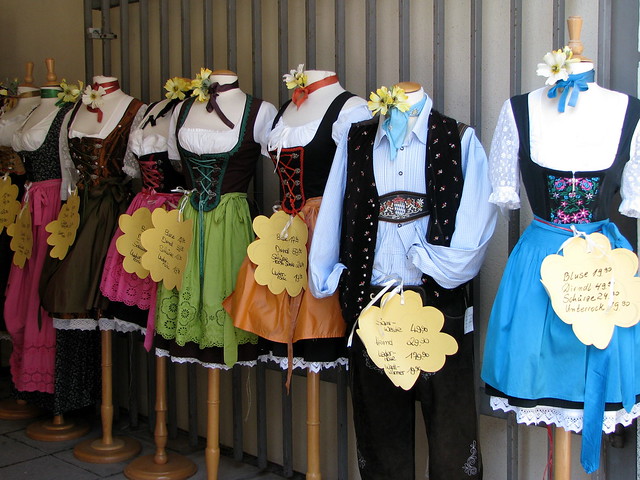All About The Lederhosen and Dirndl Posted by Constanze on Sep 25, 2015 in Culture, Language, Traditions
As Oktoberfest is in full swing in München, many of you will be seeing (or wearing!) the traditional garments known as Lederhosen or Dirndl. In this post, I’m going to tell you a little about where they originate, why they were worn (and how they are worn today), and give you a few other facts and related vocabulary along the way!
“MB-Tracht paar” by The original uploader was Aquajazz at German Wikipedia. Licensed under CC BY-SA 2.0 de via Commons.
First off, the Lederhosen and Dirndl are traditional Bavarian dress. Note I said Bavarian, not German! Although Germans are stereotyped outside Germany as being Lederhosen-wearing, Dirndl-clad folk, this traditional style of dress is inherently Bavarian, and you will not see it worn anywhere outside Bavaria (except perhaps at beer festivals, for fashion rather than for tradition). So: Bavarian. Not German. Got it? 😉 Guad! (That means ‘good’ in Bavarian!)
The general name for this style of Bavarian dress is Tracht, which is a word related to the verb ‘tragen’ – to wear/carry. This word is not limited to Bavaria, however, as it can be used to describe regional or specific kinds of dress anywhere in Germany. Shops selling Bavarian Tracht are often called things like Trachtenwelt (‘traditional dress world’) or Trachtenmode (‘traditional dress fashion’), so look out for them if you’re ever Dirndl shopping in München!
Now onto the history. Dirndl and Lederhosen originated in the Alpine regions of Germany, Austria and Switzerland, and can be traced as far back as the 1600s. They were worn by farmers, shepherds, carpenters and peasants for outdoor work (for the men) and indoor housework (for the women). The Lederhosen were especially suitable for work, as the leather made them extremely strong and durable. Meanwhile, the Dirndl had an apron tied around it (a feature that has remained to the day), making it ideal for housework and cooking. These clothes were never associated with city life, which makes it all the more remarkable how popular they are in the Bavarian capital today.
In the 1800s the first Trachtenvereine (‘traditional dress clubs’) were founded – a reaction from the Bavarians to modernity, and the fear that their traditions were dying out. These kinds of clubs flourished, and still exist today as a way for Bavarians to wear and celebrate their Tracht.
Here’s a video of one such Trachtenverein performing a traditional dance:
Today, the Dirndl and Lederhosen are worn in the following ways:
- For working purposes, as they were worn in the past (mostly in rural areas). Many restaurant waitresses also wear Dirndls, and this includes restaurants that are out in the sticks; they are not just for the sake of tourists, but for the sake of tradition and convenience
- As leisure clothing (eg. to go to a beer garden in, or to wear around the house)
- As everyday wear – by people, quite simply, who are proud of their heritage and want to show it off
- For special events – such as Oktoberfest and other festivals
- For weddings – Just as Scots often wear Kilts to their weddings, some Bavarians get married in Dirndl and Lederhosen! Aww!
The last bullet point I’m going to mention is that they are worn for fashion purposes. This is where the modern Lederhosen and Dirndl styles come into play. As a result of the worldwide attraction that is Oktoberfest, Tracht is back in fashion, and there is no end to the variations of the Tracht you can buy today. They – the Dirndls especially – come in all sorts of colours, lengths, styles and fabrics, ranging from the simple to the elaborate, and from very modest to very, err, revealing!

Also popular with women is to wear a version of the men’s Lederhosen instead of the Dirndl. Photo: avarty on flickr.com under CC BY-SA 2.0
Many Bavarians own at least one Dirndl or Lederhosen, but if you’re a tourist visiting Oktoberfest, for example, there is always the option of renting an outfit from a Trachtenverleih (‘Tracht rental place’) like Bavarian Outfitters if you don’t want to buy one (they can be rather expensive, especially if you want a traditional or elaborate one).

Dirndl and Lederhosen for sale. You can buy the individual items separately, and they are priced as such. Photo: 90389546@N00 on flickr.com under CC BY-SA 2.0
What do you think of the Bavarian Tracht? Do you prefer the traditional or the modern style? Do you own one? Leave me a comment!
VOCABULARY
Diandl – Bavarian way of saying Dirndl
Ledahosn – Bavarian way of saying Lederhosen
Blouse – die Bluse
Skirt – der Rock
Dress – das Kleid
Corset – das Korsett
Apron – die Schürze
Hat – der Hut
Feather – die Feder
Shirt – das Hemd
Trouser braces/suspenders – die Hosenträger
Shepherd – der Schäfer
Farmer – der Bauer
Carpenter – der Schreiner

Build vocabulary, practice pronunciation, and more with Transparent Language Online. Available anytime, anywhere, on any device.
About the Author: Constanze
Servus! I'm Constanze and I live in the UK. I'm half English and half German, and have been writing about German language and culture on this blog since 2014. I am also a fitness instructor & personal trainer.








Comments:
ernstlicht:
Hello,
Thanks for sharing for All About information The German Lederhosen & Dirndl.
Jan:
Servus Constanze,
thanks for providing this very usefull article which sums up all important facts about the german lederhose. Thumbs up!